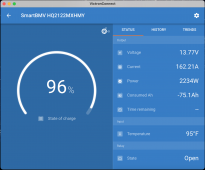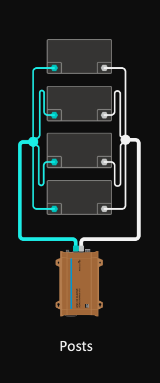crayfish21
New Member
- Joined
- Mar 12, 2022
- Messages
- 8
I'm confused how 30a at 120v from shore power gets translated through an inverter/charger into a 12v battery bank.
For example, if I have six 206ah SOK 12v batteries wired in parallel and I'm charging from 30a shore power via a Victron Multiplus inverter/charger, how much will each battery be charged per hour (assuming I'm only using shore power to charge batteries)?
Will my 1236ah battery bank be fully charged from empty in:
7 hours (charging at a rate of 30a per battery per hour?
40 hours (charging at a rate of 5a per battery per hour?
Or neither, because the charging amperage is different than the shore power amperage because of the change from 120v to 12v?
If I'm understanding the Victron Multiplus inverter/charger data sheet correctly, the 3000w models can charge batteries at a current up to 120a while the 2000w is up to 80a. With a 30a 120v shore power connection, is there no theoretical difference in battery charge speed performance between the two models? Or is the 30a from shore power at a higher amperage once it gets converted to 12v by the Multiplus?
According to the SOK data sheet, recommended charge current is 40a. Is my understanding correct, that if I were to send 120a from the Victron to the six batteries, it would be divided amongst the batteries at roughly 20a per battery?
Thanks for the help!
For example, if I have six 206ah SOK 12v batteries wired in parallel and I'm charging from 30a shore power via a Victron Multiplus inverter/charger, how much will each battery be charged per hour (assuming I'm only using shore power to charge batteries)?
Will my 1236ah battery bank be fully charged from empty in:
7 hours (charging at a rate of 30a per battery per hour?
40 hours (charging at a rate of 5a per battery per hour?
Or neither, because the charging amperage is different than the shore power amperage because of the change from 120v to 12v?
If I'm understanding the Victron Multiplus inverter/charger data sheet correctly, the 3000w models can charge batteries at a current up to 120a while the 2000w is up to 80a. With a 30a 120v shore power connection, is there no theoretical difference in battery charge speed performance between the two models? Or is the 30a from shore power at a higher amperage once it gets converted to 12v by the Multiplus?
According to the SOK data sheet, recommended charge current is 40a. Is my understanding correct, that if I were to send 120a from the Victron to the six batteries, it would be divided amongst the batteries at roughly 20a per battery?
Thanks for the help!






